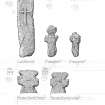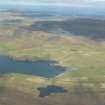Unst, Lund, St Olaf's Chapel And Churchyard
Burial Ground (Medieval), Chapel (Medieval), Church (12th Century), Churchyard (Medieval) - (Post Medieval)
Site Name Unst, Lund, St Olaf's Chapel And Churchyard
Classification Burial Ground (Medieval), Chapel (Medieval), Church (12th Century), Churchyard (Medieval) - (Post Medieval)
Alternative Name(s) Lunda Wick; St Olaf's Church; Lund Cemetery
Canmore ID 64
Site Number HP50SE 6
NGR HP 56693 04094
Datum OSGB36 - NGR
Permalink http://canmore.org.uk/site/64
- Council Shetland Islands
- Parish Unst
- Former Region Shetland Islands Area
- Former District Shetland
- Former County Shetland
Lundawick 1 (St Olaf), Unst, Shetland, cruciform stone
Measurements: H 0.76m, W 0.14m
Stone type:
Place of discovery: HP 5669 0409
Present location: in the churchyard at Lund.
Evidence for discovery: recorded by RCAHMS in 1930.
Present condition: good.
Description
This irregularly shaped cruciform stone has short arms and a rounded upper arm.
Date: ninth to eleventh centuries.
References: RCAHMS 1946, no 1541; Scott & Ritchie 2009, no 102.
Compiled by A Ritchie 2016
Lundawick 2 (St Olaf), Unst, Shetland, cruciform stone
Measurements: H 0.84m, W 0.32m
Stone type:
Place of discovery: HP 5669 0409
Present location: in the churchyard at Lund.
Evidence for discovery: recorded by RCAHMS in 1930.
Present condition: good.
Description
This is a rare example of a cruciform stone with a small pecked cross between the two short side-arms. the upper arm is broad and rounded, while the shaft flares a little and then tapers to a rounded point.
Date: ninth to eleventh centuries.
References: RCAHMS 1946, no 1541; Scott & Ritchie 2009, no 103.
Compiled By A Ritchie 2016
Lundawick 3 (St Olaf), Unst, Shetland, cruciform stone
Measurements: H 0.94m, W 0.53m
Stone type:
Place of discovery: HP 5669 0409
Present location: in the churchyard at Lund.
Evidence for discovery: recorded by RCAHMS in 1930.
Present condition: good.
Description
This cruciform stone has short squared side-arms, a flared upper arm and a round-footed shaft.
Date: ninth to eleventh centuries.
References: RCAHMS 1946, no 1541; Scott & Ritchie 2009, no 104.
Compiled by A Ritchie 2016
Lundawick 5 (St Olaf), Unst, Shetland, cruciform stone
Measurements: H 0.96m, W 0.32m
Stone type:
Place of discovery: HP 5669 0409
Present location: in the churchyard at Lund.
Evidence for discovery: recorded by RCAHMS in 1930.
Present condition: good.
Description
A long triangular slab has been carved into a cruciform stone by creating rounded notches above and below the side-arms, leaving short squared arms.
Date: ninth to eleventh centuries.
References: RCAHMS 1946, no 1541; Scott & Ritchie 2009, no 106.
Compiled by A Ritchie 2016
Lundawick 6 (St Olaf), Unst, Shetland, cruciform stone
Measurements: H 0.64m above ground, W 0.32m
Stone type:
Place of discovery: HP 5669 0409
Present location: in the churchyard at Lund.
Evidence for discovery: recorded by RCAHMS in 1930.
Present condition: good.
Description
This slab has been shaped into very short side-arms and a short flaring upper arm.
Date: ninth to eleventh centuries.
References: RCAHMS 1946, no 1541; Scott & Ritchie 2009, no 107.
Compiled by A Ritchie 2016
Lundawick 9 (St Olaf), Unst, Shetland, cross-slab
Measurements: H 1.24m, W 0.32m
Stone type:
Place of discovery: HP 5669 0409
Present location: in the Unst Heritage Centre at Baltasound.
Evidence for discovery:
Present condition: worn.
Description
On the upper part of one broad face of this slab is carved a cross in low false relief.
Date: ninth to eleventh centuries.
References: Scott & Ritchie 2009, no 124.
Compiled by A Ritchie 2016
Lundawick 10 (St Olaf), Unst, Shetland, carved stone
Measurements: H 1.42m +, W 0.72m +
Stone type:
Place of discovery: HP 5669 0409
Present location: in the church at Lund, re-used as the lintel to a window in the north wall. Although the church dates back to the twelfth century, this window is thought to be a later insertion.
Evidence for discovery:
Present condition:
Description
Incised on this slab are two lines converging towards a diamond-shaped tip. This design perhaps resembles a club rather than either a fish or a serpent and is undatable.
Date: early medieval or later.
References: Gifford 1992, 496-7; Scott & Ritchie 2009, no 130.
Compiled by A Ritchie 2016
HP50SE 6 56693 04094
(HP 5668 0412) Church (NAT) (In Ruins).
OS 6" map, Shetland, 2nd ed., (1900).
A roofless 12th century church, standing in its graveyard. It is oblong and single-chambered, and measures 47'5" (14.5m) by 22'2" (6.76m) over walls varying from 3'6" (1.1m) to 4'6" (1.37m) in thickness. The east portion has evidently been rebuilt upon the old foundation for a length of some 17' (5.19m). The fabric is in an extremely bad state of repair. The masonry, local rubble in lime mortar, is rough.
A built-up doorway can still be traced at the west end of the south wall, but the present entrance is in the west gable and is archaic in appearance, having inclined jambs - a Celtic, not a Romanesque, feature. To the south of the church are eight headstones in the form of rude stone crosses, and within the church are the tombs of two 16th century Bremen merchants.
RCAHMS 1946.
The ruin of an Established church dismantled about 1770. The graveyard is still in use.
Name Book 1878
The roofless shell of a church as described and planned by the RCAHMS. The graveyard, now enlarged, is still used and the headstones as illustrated are in situ.
Visited by OS (NKB) 5 May 1969
One of the window lintels has a fish (or serpent?) carved on it, which clearly pre-dates its use as a lintel stone.
Information contained in letter from V Turner, Shetland Amenity Trust, 14 September 1989.
Trial Trench (2006)
HP 566 040 A desk-based study and programme of trial trenching were carried out in response to a proposal to extend the existing cemetery at Lund. The site lies adjacent to the 12th-century church, dedicated to St Olaf, and an existing cemetery. Numerous sites of all periods are recorded within the wider hinterland. Trenching covered some 20% of the proposed extension area; localised but ill-defined deposits of an archaeological nature were noted. These consisted of ash-rich soils, a small amount of coarse pottery and some possibly worked quartz flakes.
Sponsor: Shetland Islands Council.
H Moore and G Wilson, 2006.
Note (17 April 2025)
"Church (In Ruins)" and encompassing "Burial Ground" are depicted on the 1st edition of the OS 6-inch map Shetland, Sheet VIII (1882). "Graveyard" is shown with larger footprint (extended to the SW) on the HES 5k record sheet (raster).
Current extent of graveyard including a further rectangular southern expansion defined / digitized from orthoimagery provided by Bluesky International Ltd. OS 1km map square HP5604 flown on 3 May 2024.
Information provided by HES (C DeDeo) 17 April 2025.
























































